If you’re reading this page, likelier than not, you are interested in going into the backcountry. You should; it’s dope. Great workout, all the powder, none of the people.
But let’s preface this by saying that research online is not a substitute for a formal avalanche awareness education. This page is educational-only and should only be used to refresh current knowledge or for curiosity. This page is written by a 21 year old college student who is in NO WAY an expert in the field. Please if you are interested in starting your backcountry career, sign up for a formal class. Yes, they are expensive, yes you need them to ensure you have the knowledge to be safe in the backcountry. Backcountry travel is pricey, and the class and your knowledge is the best piece of gear you can ask for. You can sign up for formal classes and find videos by experts at:https://www.americanavalancheinstitute.com/, https://avalanche.org/, https://avtraining.org/.
That being said, here are a few of the basics:
Before you travel in the backcountry, you should always have the proper knowledge, a partner and a plan. Having the proper knowledge means following weather patterns in the area in which you want to ski, looking at the avalanche forecast to see what specific problems you need to watch out for, and, of course, having some formal avalanche education. You can find avalanche forecasts at: https://avalanche.org/, and specifically for the Eastern Sierra at: http://www.esavalanche.org/.
Choosing a good avalanche partner is extremely important — if shit hits the fan, you could be relying on this person to save your life and vice versa — so, you want to make sure that the partner you are going into the backcountry with also has some knowledge and someone you can trust.
Lastly, you want to create a plan. You want to know where you’re going to go. I like using https://www.gaiagps.com/, but I know others who like using https://caltopo.com/.
There are three (or four, depending on who you ask) pieces of gear that are essential to backcountry travel: beacon, shovel, probe, (and avalanche backpack). Why are these pieces essential? Well, a beacon will help you find your partner, or help your partner find you, should one of you be buried in an avalanche. A probe will help you find out where your partner is buried and where you should start digging. A shovel will help you dig your partner out. Some argue that an avalanche airbag backpack is another essential piece of gear; some studies have shown that using one of these packs will improve your chances of survival, if you’re in an avalanche by 27%.
As always, it’s always a good idea to carry these few other things when going in the backcountry: extra warm layers, food, water, cell phone, matches, satellite phone, med kit, gear kit, and ski straps. Ski straps are god’s gift to mankind and no one can convince me otherwise.
Almost all avalanches occur on any slope between 28 and 45 degrees, with 38 being the sweet spot to trigger a slide. Any slope below 28 degrees generally does not provide enough stress or steepness for an avalanche to slide on, and slopes above 45 degrees tend to be too steep for snow to stick. On slopes above 45 degrees, you will see a lot of “sluffing,” which is just snow sliding down, not in a slab. You are in avalanche terrain when you are on a slope of 28 to 45 degrees or below a slope of 28 to 45 degrees.
Avalanches need a sliding surface, a weak layer and a slab to occur. A sliding surface can also be more snow below the weak layer or the ground. The weak layer can be a ton of different things: facets, surface hoar, a crust after a melt-freeze cycle, etc. The slab is snow that has bonded together on top of the weak layer.
Avalanches also need a trigger. When there is an avalanche accident, the trigger is almost always the victim or someone in the victim’s group. In some snowy areas, ski resorts, or highway avalanche controls will purposefully trigger avalanches with explosives or ski cuts. And in extreme avalanche conditions, avalanches can be triggered naturally by a cornice falling, wind, rain, sunny weather, or other weather conditions.
Skinning is how you get up the mountain. Ski or splitboard skins are pieces of specialized fabric that you put on your skis that allows you to walk uphill. Everything that applies to avoiding avalanches for skiing downhill also applies for skinning uphill. 30% of avalanches occur when skinning uphill, which might sound surprising, but you spend 70%+ of your day moving uphill. While most skiers I know don’t think about avalanche mitigation as much on the up as on the down, it is essential to your safety to choose good skin tracks. When you are skinning uphill, the consequences can be much more extreme as your feet can be locked into your bindings, and everyone moves slower skinning than skiing. See the Terrain section for more about choosing good paths, but in general, staying on ridge lines and skinning up low angle sections is always a good idea.
There are 9 types of avalanches, each of which presents different problems, or terrain you want to look out for.
Dry Loose – This avalanche is also called a point release or sluff and is often fan-shaped. They start from a point and gather more snow as they go downhill. Dry loose avalanches are less likely to bury a person than slabs, but can carry high consequences if above terrain traps or in sketchy terrain.
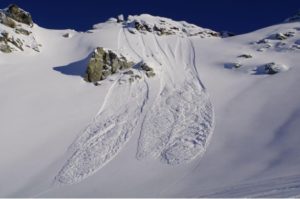
Wet Loose – This avalanche is also called a point release or sluff. Similarly to the dry-loose avalanche, it begins at a point and becomes fan shaped as it gathers more snow. These avalanches are likelier to happen in the spring or after periods of intense warming.

Wet Slab – Wet slabs often occur after warming events or rain on snow. They happen after water has loosened the bonds between the slab and the surface beneath. They move more slowly than other slab avalanches (20 mph), but can be extremely destructive and unpredictable.
Storm Slab – Storm slabs occur after new snow forms a slab on top of an older weak surface. This avalanche problem can last from a couple of hours to a couple of days after the storm has ended, but it can also turn into a persistent slab problem, or a deep persistent slab problem. Storm Slab Avalanches on Vimeo
Wind Slab – Wind can carry up to 10 times more snow than a storm can deposit. Wind slab avalanches often occur on the downwind, or leeward slopes, which means if the wind is blowing from west to east, you might want to avoid eastern slopes. Wind slab avalanche – 29 Mar 2019
Persistent Slab – Persistent Slab and Deep Persistent Slab can be season-ruining problems. Persistent Slab avalanches occur when slabs form on top of facets, surface hoar, depth hoar or other weak layers. They can last for days, weeks or months. They can be extremely hard to predict and dangerous.
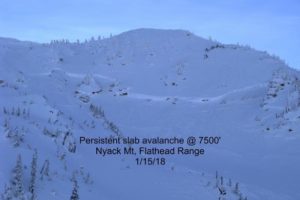
Deep Persistent Slab – Deep Persistent Slab avalanches are when persistent slab problems are buried deeper in the snowpack. They’re more likely to be deep slabs on top of depth hoar or weak layers.
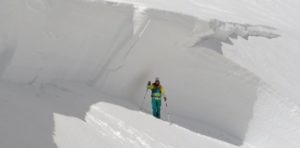
Cornice Fall – Cornice Fall avalanches occur when an overhanging mass of snow (called a cornice) breaks off from the slope and falls onto the slow below. They can trigger larger point-releases or slab avalanches. To avoid cornice falls, avoid travelling on top of cornices all together, when possible and use extra caution when around them.
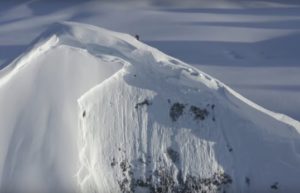
Glide – Glide avalanches are straight nightmare fuel. They occur when the entire snow cover releases, to the ground, and slides. They often occur on isolated, steep and smooth slopes and can be characterized by a glide crack, a large crack that forms in the snow cover anywhere from seconds to months before the slide happens. They are unlikely to be human triggered, near impossible to forecast, and an extremely dangerous avalanche problem to manage.

If avalanches are in question, terrain is the answer. Choosing what you are going to ski on any given day can be the difference between encountering many red flags of avalanche activity or having a great day of skiing pow, without any sphincter-tightening moments.
If the avalanche danger is considerable or higher, you might want to stick to skiing terrain below 28 degrees. Some nice and easy low angle trees could be a good idea. If wet slides are the prominent avalanche problem, skiing on westward facing slopes in the morning, then moving on to north facing might be in order. And, if wind slab is the problem, you’ll want to ski on the windward slope, not the leeward.
The other thing about choosing terrain is envisioning avalanches occurring in your area. Part of picking terrain to ski is avoiding terrain traps. Terrain traps are areas in which even the smallest of avalanches could have severe consequences. For example: a gully, a lake, cliffs, a crevasse field, trees, etc. You could have a small avalanche that would normally only bury you in 1 or 2 feet of snow, but if that avalanche path ends in a gully, you could be under 10 feet or more, basically ending your chances of survival. Similarly, if you are caught in an avalanche and it sends you off a 200 foot cliff, your odds ain’t good. So, you want to choose where you are going to ski wisely when going into avalanche terrain.
Terrain also means looking around and seeing if there have been signs of avalanches in your path. Areas where there are no trees (and there should be) can be a red flag. In general, if you are skiing wooded areas, you want “happy forests.” A happy forest is one in which all the trees have branches. Flagging, or when a tree has all of its branches ripped off on one side, is a sign of avalanche activity, especially when it is widespread in a certain area. Another sign is when trees are lacking branches from maybe 3-5 feet above the ground downward. This could mean that avalanches rip through the forest, taking the branches of the trees with them.
ALPTRUTH is a super useful acronym that can help you decide whether it is a good idea to go out into the backcountry. It was created as a way to mitigate what the risks are without needing to step onto the snow. For every “yes” to the questions below, tally one point. 98% of avalanche accidents occur when 3 or more of these red flags are prevalent. 92% of accidents occur with 4 or higher.
Avalanches: Have there been avalanches in the past 48 hours?
Loading: Has there been significant snow, wind or rain in the last 48 hours?
Path: Is there a clear avalanche path (identifiable by a novice backcountry skier)?
Terrain trap: Are there terrain traps in your planned route for the day?
Rating: Is the rating above considerable?
Unstable snow: Is there any cracking, whumping, collapse in your tests, etc?
Thawing: Has there been recent warming, due to the sun, rain, or air?
What happens to the snowpack after it falls is based on a few different factors. Warming/melt freeze, rain, wind, and sun can create crusts. Temperature gradients can either help or hurt the snowpack. Temperature gradients form based on the difference of outside temperature versus the ground beneath the snow. The ground will always be right around 32°F, and if the temperature outside is much colder, it can do funky things with the snow. The snow will be a gradient of temperatures, hence temperature gradient, between the 32°F ground and however cold the air is.
Rounds – WE LOVE ROUNDED SNOW. Rounded snow forms when the snowflakes lose all of their spiny outsides and become round little spheres. Rounds love bonding to one another and form a super strong snowpack. Rounding occurs when there is a small difference between the air temperature and the ground, or a weak temperature gradient.
Facets – Facets are also nightmare fuel. Facets can absolutely destroy your season in the backcountry. They are extremely weak snow crystals that almost look like little pyramids. Unlike rounds, facets do not like to bond with one another. When doing snowpack tests, you can tell facets from rounding or good snow because they bounce around like grains of sugar and are super difficult to form snowballs with. Facets form when there are large temperature gradients in the snowpack, so often when there are very cold days. Strong gradients in temperature turn rounds to facets, and weak gradients can turn facets back into rounds. Explained: Why cold temperatures create facets – 29 Nov 2015
Depth Hoar – Super extremely faceted snow normally near the ground. Normally what causes deep persistent slab avalanche problems.

Surface Hoar – Surface Hoar is formed on still, cold nights by water vapor escaping from the snowpack. It is the dew of winter and often looks like crazy feathers sticking out of the snowpack. Surface hoar is great when it is on the surface, but when it is buried in the snowpack it can act like rows of wine glasses with a slab on top. Surface hoar can be a dangerous weak layer, and it is important to watch the snow in your area to document when surface hoar has formed.
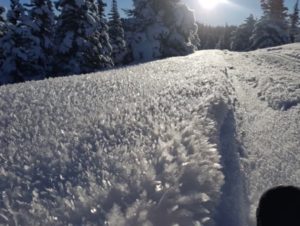
Rain Crust – Rain crust is when it rains, then freezes and forms a crust that tends to be smooth and found at all aspects, but NOT all elevations. Crusts are brittle, smooth and do not like to form to the snow above and beneath them, forming a discontinuity in the snowpack and becoming a problem for avalanches.
Sun Crust – Suncrusts are less smooth than rain crusts, but still pose similar avalanche problems. However, sun crusts tend to be more aspect based, rather than elevation. To avoid sun crusts, you should ski north facing slopes or slopes that don’t see a ton of sun throughout the day.
Melt Freeze Crust – Similar to sun crusts, but instead of melting due to the sunlight, the snow melts due to air temperature. Poses similar avalanche problems.
Wind Pack/Crust – Is not the same as a Wind Slab avalanche, and tends to break locally, instead of propagating. It does not pose significant avalanche problems, unlike the other crusts. Is created by the wind forming a hard pack by pushing snow together.
Rime – Super crunchy tough snow that you can see plastered onto the trees and chairlifts, usually at high elevations. Rime grows INTO the wind, as opposed to wind loaded snow, which grows away from the wind.
While I’ve written a lot about snow and the different natural factors that can influence avalanches or avalanche problems, the number one contributing factor to avalanche fatalities and accidents is the human factor. The human factor is how we make decisions, take in knowledge and observe the world around us. It is all about decision making and risk assessment.
Countering the human factor could be as simple as listening to your gut feeling of “oh something’s not right here,” but often it takes practice and conscious effort. The human factor is often described or articulated as these downfalls called “heuristic traps.” Heuristic traps are situations in which people often ignore the “red flag” signs around them because of a certain condition. An easy way to remember what each of the Heuristic traps are is the acronym FACETS.
FACETS is an acronym used to describe the common heuristic traps that people tend to fall into.
Familiarity – This trap often occurs with a route one is familiar with. It can be the feeling of “I’ve skied this like ten times and it’s held up every time.” Instead of planning the backcountry tour with the same scrutiny and awareness that one would for something new, the skeir often disregards serious risks because of their familiarity with the terrain. Something that is familiar to us usually feels safer, but that is not the case in avalanche terrain with constantly changing conditions.
Acceptance – This can also be called the “wet blanket” trap. This trap is when you’re traveling with a group and don’t want to be the one to “chicken out” or “ruin the day.” When someone falls into this trap, they often don’t speak up when they feel uncomfortable with something because he or she is trying to “fit in.” This trap is most often seen in mixed-gender groups, rather than single-gender. Studies have also shown that men are less likely to speak up about their concerns when they have women in their group (sorry boys). So, next time you travel into the backcountry, be cognisant of how group dynamics are affecting your ability to let things slide versus speak up.
Commitment – This heuristic trap often occurs on a long day. It’s the idea of “we’ve spent all this time, money, and skinned all this way, there’s no way I am leaving without skiing this line.” This can blur your judgement as to whether or not you SHOULD ski the line, no matter how badly you want to.
Expert Halo – This heuristic trap can occur when you are skiing with someone who has more experience than you do. Instead of speaking up when you feel like there’s something wrong, you think “this guy/gal knows what they’re doing, who am I to question it.” Even if someone has more experience, they can miss an obvious sign of avalanche activity and you should always speak up if you have concerns about the snowpack or terrain.
Tracks – This heuristic trap can occur when you see tracks on a certain slope that you might want to ski. Although this slope is not what you would have chosen for the day, you figure “if these people could do it, it’s probably okay.” Avalanches don’t always occur with the first person to ski a slope. Just as my mom used to say “just because your friends jumped off a cliff, would you?,” and that is the same mentality I use when looking at a slope with tracks on it. Don’t let other people’s shitty avalanche decisions determine your route.
Scarcity – This is the opposite heuristic trap of tracks. For all you intense powderhounds, this one’s for you. This trap occurs when you look at a non-tracked, awesome slope. Instead of evaluating the different risks, you think “I’ve got to get to this before anyone else does, fresh tracks for the win!” Obviously, this poses risks as you are quick to jump to a decision based on there being no tracks, and looking at powder as a scarce, precious natural resource. Good powder days happen multiple times a season, don’t let the hunt for pow cloud your judgment and hinder or end your skiing career.
Let me reiterate that this article is not meant to be a replacement to formal avalanche education and experience. No snow or adventure is worth your life, and you should be mindful of the extreme risks you take every time you go into the backcountry. Avalanches are not a fucking joke and should be taken with the seriousness any other life-threatening event would hold. Please, if you are interested in starting your backcountry career, we urge you to visit https://avtraining.org/, https://www.americanavalancheinstitute.com/, or https://avalanche.org/, to find a class taught by avalanche professionals. This article is written by a 21 year old college student and I am in NO WAY an authority on the world of avalanches.
As climate change continues to fuck up our snowpacks, please be congiscent of all the different factors that can lead to avalanche accidents. Track the snow in the area in which you plan to tour and get all the information you can, your life may depend on it
https://oopskayak.org/resources/Documents/Organizers/McCammonHTraps.pdf
https://www.nytimes.com/projects/2012/snow-fall/index.html#/?part=tunnel-creek
https://avalanche.org/avalanche-accidents/
http://www.backcountryzero.com/the-fine-line-podcast